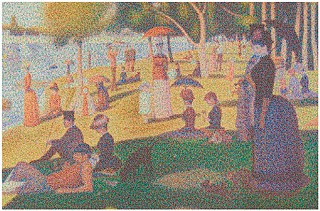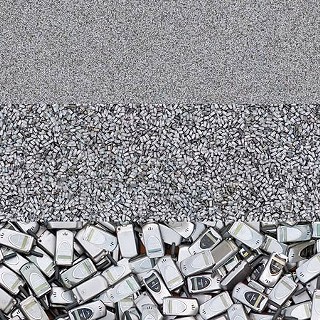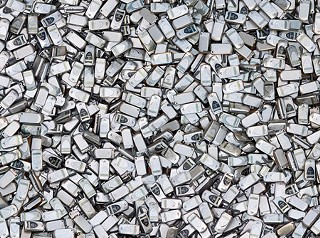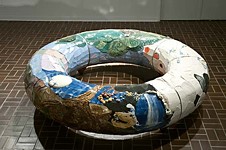Increments of Destruction
Chris Jordan's 'Running the Numbers' at Austin Museum of Art
By Wayne Alan Brenner, Fri., July 2, 2010

"What is any ocean but a multitude of drops?"
– David Mitchell, Cloud Atlas
A picture, they say, is worth a thousand words. And how many numbers is that picture worth?
Americans use 60,000 plastic bags every five seconds. Twenty-eight thousand 42-gallon barrels of oil are consumed in the United States every two minutes. Four hundred twenty-six thousand cell phones are "retired" in the U.S. every day. One hundred million trees are cut down in this country each year to make the paper for junk mail.
Big numbers. Ooh, ooh, big giant numbers. The implications would chill you, maybe even inspire heart-racing terror, if only you could wrap your head around all those big fucking numbers. But, cognitively, we're at a loss; we're stuck in the tallying of prehistory. One, two, three, many: That's about it. You move into the hundreds and beyond, you might as well try to get to first base with infinity. What would these big numbers even look like?
Chris Jordan, whose mind-blowing "Running the Numbers" exhibition is currently shocking the verticals at the Austin Museum of Art, knows what those numbers would look like. He's depicted what they do look like, in image after wall-sized image, using research and photography and software and a design sense of the caliber more often used to sell you things than to portray the hazardous consequences of reckless consuming.
Twenty-nine thousand, five hundred sixty-nine handguns in a pile as large as the eye can see, equal to the number of gun-related deaths in the U.S. in 2004. Two-point-three million folded prison uniforms stacked together, equal to the number of Americans incarcerated in 2005. One hundred twenty-five thousand $100 bills ($12.5 million), the amount our government spends every hour on the war in Iraq, arranged to form an enormous portrait of Benjamin Franklin.
You think you've logged a lot of hours in Photoshop, design maven? The point-and-click muscle of Jordan's right index finger could probably flip a Humvee.
"The pieces that are on display here," says the artist, "I didn't use any stock photography; I did all of them myself. Like, to make the Seurat piece with the cans," he nods toward his homage to A Sunday Afternoon on the Island of La Grande Jatte, "I went to all the markets in town and brought back 80 aluminum cans. Then I made a little pedestal in my studio and photographed each can at five different rotations – so if a bunch of cans ended up next to each other in the final image, they wouldn't look too duplicative. Then I turned down the lights and made five pictures ... turned up the lights and made five pictures ... and did the same with neutral lighting. So I ended up with 15 pictures of each can at different brightness levels. And then, in Photoshop, I made a slightly cooler and a slightly warmer version of each one of those, and I cropped them all so they were exactly the same pixel size, so they'd fit together with no white space in between. And I ended up with a folder of ... I can't remember exactly how many, something like 400 or 800 images in a folder. And then I worked with a photo-mosaic program. I knew I needed 106,000 cans, so I got a high-resolution image of the Seurat painting and rezzed it down until it was exactly 106,000 pixels, so each pixel could be replaced by one can. And the mosaic program goes and finds that pixel number 1 in the upper left corner has an RGB – a red-green-blue – value of whatever, and it goes and looks through all the images in the folder, and it averages the pixel values for all of those images, and it goes 'Oh, can number 623 goes right there.' And so on, until the entire thing is completed."
But, hold on a minute here. The internationally renowned Chris Jordan, the man whose "Running the Numbers" tours all over the country and has been presented at the TED talks and featured in newspapers and journals and magazines and TV shows and blog after blog after blog? He has no ... interns?
"Now I have interns, because it recently occurred to me, 'Wait, I don't need to do 20,000 cut-and-paste clicks in Photoshop: I could have someone help me!' But I didn't have any when I was creating the pieces for this exhibition."
The work, in these photographic mosaics and the other, nonallusory pieces: labor-intensive, for both man and machine. The results, due to Jordan's professional manipulations of shape and pattern and hue: stunning, for all who can see. The irony: not lost on this artist who, before he moved deeply into photography and the cautionary beauty he could render from its potential, was a corporate lawyer for British Petroleum, defending that beleaguered company against litigation surrounding an oil-pipe explosion.
"That's right," says Jordan, nodding, a lopsided smile brightening his handsome features. "And of course, the general irony of my work is very uncomfortable to deal with. The pieces themselves are all printed on petroleum-based plastic paper, using petroleum-based inks, and they're laminated with petroleum-based surface laminate. They're framed in wood and put into wooden crates, and they travel around the country in a truck that leaves a thousand-mile-long line of diesel smoke behind it everywhere it goes. And I flew here in a jet to say that." He laughs, and his laughter is tinted with embarrassment and rue.
"I would guess," says your reporter, "that the effect these pieces probably have will far outweigh that footprint, though, right? Because how many thousands and, with the Internet, eventually millions of people are going to see this work and make changes in their lives? Even incremental changes, which will build up. I mean, the next time someone goes to throw something away – that cell phone, those bottles, a plastic bag – the visual memory is going to stop them, going to make them think. Because of the art you've taken pains to create here."
"Yeah," says the artist, "I'm like the guy at the party where everybody's clinking their glasses and having a good time, and I'm like: 'No, no, no! Everybody stop – we have to deal with the big bloody rhinoceros head over in the corner!'"
The work: labor-intensive, for both man and machine. The results: stunning, for all who can see. The impact: Only time will tell, as the world turns and the human-produced detritus that's confounding and killing so many of its inhabitants continues to pile up. But Jordan – with a bloody rhinoceros head to guide him – toils on.
"When you stand back from one of these pieces," he says, "you can't make out the individual images – you can only see the collective image that they add up to. And then, when you move closer, you see that the collective is made up of lots and lots of individuals. And when you get up really close, you can only see the individuals and you can't see the collective anymore. It's this sort of deep, zooming thing that we have to deal with as individuals in an incredibly complex society, in the world of 6.7 billion people. And I wrestle with the question – and I think we're all wrestling with it, in one way or another – of 'Do I matter?' And 'Does my consumption make a difference, to the point where I should make changes to my behavior?'
"Because it's easy to make the argument that, if I bother to turn off the light when I leave my studio, there are still whole cities of millions of people with their lights on all the time, so will it really make a difference if I try to reduce my own consumption?
"In the green movement, there's this kind of one-dimensional argument that you keep hearing, which is that Every Vote Counts and You, Too, Can Save the World. Which is true, really; but there's this other truth, and that's that each of us is one of that 6.7 billion. And another way you can look at it is: Of course every one of us matters. That's how we got into this giant mess in the first place: hundreds of millions of people behaving as if they don't matter. And the question I have is, 'How can we collectively begin to choose a different way, given that we're all individuals with freedom of choice?' That's the issue I'm trying to raise with all of this work."
"Chris Jordan: Running the Numbers" is on display through Aug. 15 at the Austin Museum of Art – Downtown, 823 Congress. For more information, call 495-9224 or visit www.amoa.org.















